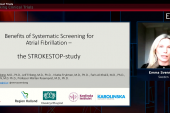Device-Detected AF Directly Linked to Ischemic Strokes
The findings bolster calls from experts for new trials of time-limited, “pill-in-the-pocket” anticoagulation.

In patients with cardiac implantable electronic devices (CIEDs) that provide continuous rhythm monitoring, episodes of atrial fibrillation (AF) lasting at least 5.5 hours are associated with a greater risk of ischemic stroke, particularly in the first few days, a study confirms.
The risk was most apparent in the first 1 to 5 days after the AF episode (OR 5.00; 95% CI 2.62-9.55) and then dissipated quickly after that, lead author Daniel Singer, MD (Massachusetts General Hospital, Boston), and colleagues report in a study published online last week in JAMA Cardiology.
“Our work is very consistent with the notion that paroxysmal atrial fibrillation poses a risk of stroke during and for a short time afterwards but that [the risk] rapidly decreases to background,” Singer told TCTMD, adding that the findings do not support the concept that an AF episode induces strokes months and years later. “And that means that the idea of [AF being a] causal risk factor is more supported than the idea of a risk marker.”
Agreeing was Jason Andrade, MD (Vancouver General Hospital and the University of British Columbia, Canada). Though multiple recent studies had raised doubts about the causal relationship between AF episodes and stroke, this study knocks them down, he commented to TCTMD. “It’s confirmatory that, yes, AF is a cause for strokes and that people have strokes in relation to when they’re having AF episodes. That confirms what we thought but at least takes the doubt out of our minds based on the other recent studies.”
And if there is a causal link between AF episodes lasting several hours and ischemic stroke risk, Singer said, “it raises the possibility that you might just do time-limited anticoagulation” to protect against stroke. That “pill-in-the-pocket” approach involves using oral anticoagulation for a finite amount of time (maybe 30 days) after an AF episode detected by continuous monitoring rather than using it indefinitely as recommended in guidelines, which would theoretically minimize bleeding risks.
“These results provide support for trials of time-delimited anticoagulation for patients with infrequent multihour episodes of AF and rigorous, continuous rhythm monitoring,” Singer et al write.
Risk Factor or Risk Marker?
There’s no question that AF raises the risk of stroke and anticoagulation reverses that risk, Singer said. He noted, however, that studies establishing that relationship mostly involved patients who had persistent AF or a heavy burden of paroxysmal AF.
In recent years, studies of patients with implantable devices that provide continuous heart rhythm recording—TRENDS and ASSERT, for example—have indicated that brief subclinical AF episodes in patients with paroxysmal disease do not have a strong temporal relationship with ischemic stroke. That suggests that the arrhythmia may not be the proximate cause of stroke but rather a marker of other factors—like left atrial myopathy—that increase risk, Singer explained.
But the only way to definitively sort out the issue is to examine large numbers of patients with ischemic stroke who have continuous rhythm monitoring before the event, he said. He and colleagues, led by Mintu Turakhia, MD (Stanford University School of Medicine and VA Palo Alto Health Care System, CA), did just that in a 2015 study based on US Veterans Administration hospitalization claims records and Medtronic’s CareLink database of continuous heart rhythm records from patients with implantable devices. That study showed a spike in stroke risk within 30 days of an AF episode lasting several hours. “But even this analysis included only a small number of informative cases—ie, patients with discordant AF burden in the case and control time periods,” Singer et al write.
The current study, which combines the large Optum electronic health record and CareLink databases, extends those findings by including a larger number of “informative” patients. The analysis focuses on 891 patients (median age 76 years; 64.5% men) who had an ischemic stroke as well as an implantable device capable of continuous monitoring in the 120 days before the event. Using the same case-crossover design employed in the prior study, the investigators assessed AF episodes of 5.5 hours or more occurring either in the 30 days preceding the stroke (case period) or 91 to 120 days before the stroke (control period).
Overall, most patients (76.5%) had no AF episodes meeting the duration threshold in either time period and another 16.0% had AF episodes in both periods. That left 66 patients who had AF in only one of the time periods (the “informative” group)—52 with episodes in the 30 days leading up to the stroke and 14 with episodes 91 to 120 days before the event. That indicates increased odds of having a stroke shortly after an AF episode lasting 5.5 hours or longer (OR 3.71; 95% CI 2.06-6.70).
Digging deeper, the researchers found that the risk was highest in the first 5 days after the AF episode, quickly tapering after that, and that the relationship was most evident for AF episodes lasting more than 23 hours (OR 5.00; 95% CI 2.08-12.01). Moreover, the link between an AF and stroke risk was observed in patients not taking oral anticoagulation (OR 7.80; 95% CI 3.07-19.80); it was not seen among those taking an anticoagulant (OR 1.44; 95% CI 0.62-3.38).
“Our results are consistent with the traditional view that AF may be a causal risk factor for ischemic stroke in patients with CIEDs rather than a simple risk marker, although these attributes may not be mutually exclusive,” Singer et al write.
Strategies to Limit Anticoagulation Exposure
In an accompanying editor’s note, Turakhia, an associate editor of JAMA Cardiology, argues that “it’s time to rethink (and retrial) our framework for stroke prevention in atrial fibrillation,” highlighting the shortcomings of existing risk-stratification tools like the CHADS2 and CHA2DS2-VASc scores used to guide use of chronic anticoagulation. He pointed out to TCTMD that the scores were based on data from patients with clinical diagnoses of AF, most of whom were hospitalized.
The discussion about what to do with oral anticoagulation is complicated further by the fact that AF appears to be both a causal risk factor for ischemic stroke—based on this and other research—and a risk marker. Turakhia noted that “there is a causal marker here in that when you have A-fib the risk goes up, but it doesn’t explain most strokes.” Moreover, patients who have implantable devices capable of detecting AF episodes likely have vascular disease and possibly brain disease already, so AF may also be a marker of increased overall risk in that setting.
The group in which it’s most important to demonstrate a temporal link between an AF episode and ischemic stroke, Turakhia said, are patients with paroxysmal AF and low CHA2DS2-VASc scores (maybe 3 or less). AF might be the only major stroke risk factor in this group, which should be the population enrolled in new clinical trials testing time-limited anticoagulation approaches, he said. “In those patients, we need to understand what the harms are relative to the benefits of indefinite anticoagulation versus stopping it during prolonged periods of normal sinus rhythm.”
He added, “This is really a call to action. We need to come to terms with understanding that our scores are limited in scope, with an inappropriately short 1-year follow-up on which to base lifelong anticoagulation.”
In his editor’s note, Turakhia observes that a pilot trial of pill-in-the-pocket anticoagulation guided by an insertable monitor—REACT.COM—has shown the feasibility of the approach, suggesting that wearable technologies may play a role moving forward.
“If successful, reductions in total anticoagulant consumption could reduce bleeding and other complications of anticoagulation,” he writes. “With treatment guidelines calibrated to low treatment thresholds based on outdated risk scores, there is no hope of finding a generalizable, untreated population from which to derive a new score. The current data, along with the totality of evidence supporting equipoise in lower-risk AF populations, make a compelling case for a clinical trial.”
Todd Neale is the Associate News Editor for TCTMD and a Senior Medical Journalist. He got his start in journalism at …
Read Full BioSources
Singer DE, Ziegler PD, Koehler JL, et al. Temporal association between episodes of atrial fibrillation and risk of ischemic stroke. JAMA Cardiol. 2021;Epub ahead of print.
Turakhia MP. It’s time to rethink (and retrial) our framework for stroke prevention in atrial fibrillation. JAMA Cardiol. 2021;Epub ahead of print.
Disclosures
- Singer reports support from the Eliot B. and Edith C. Shoolman fund of Massachusetts General Hospital; grants from Boehringer Ingelheim and Bristol-Myers Squibb; personal fees from Boehringer Ingelheim, Bristol-Myers Squibb, Fitbit, Johnson & Johnson, Merck, and Pfizer; and royalties from UpToDate.
- Turakhia reports personal fees from Medtronic, Abbott, Sanofi, Pfizer, MyoKardia, Johnson & Johnson, Milestone Pharmaceuticals, InCarda Therapeutics, 100Plus, Forward Pharma, and AliveCor; and grants from Bristol-Myers Squibb, the American Heart Association, Apple, and Bayer.
- Andrade reports speaking fees from Bayer, Pfizer, and Servier, and research support from Medtronic.





Comments